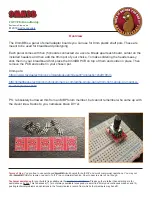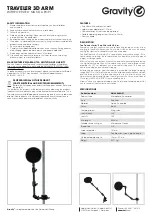
ST 500 "Piranha" Operation Manual: Use Guidelines
68
When a four-wire telephone line cable is connected, the switch contacts with numbers 3, 4, 5,
6 will be used. Wire combinations 3-4, 3-5, 3-6, 4-5, 4-6, 5-6 should be checked.
It is necessary to take into account that the transmitter can be powered normally (from the
involved "4-5" pair), and transmit information through another pair.
10. In the table set the cursor on the line corresponding to the pair "3-4". The cell displays the
voltage value in the connected pair. During normal operation of the telephone line, there is no
voltage on this pair.
11. Press "ENTER". Activity in the frequency band on the pair "3-4" will be shown.
12. If necessary, turn on the attenuator ("F4").
13. Activate the AUTOMATED mode ("F2").
14. Listen to all detected signals by switching AM/FM demodulation ("F2").
15. Exit the AUTOMATED mode ("ESC") to the "PANORAMA" mode.
16. Activate the "ELECTRONIC SWITCH CONTROL" mode ("F1").
17. Set the table cursor to the next pair of wires, press "ENTER".
18. Test all the remaining paired combinations, as described above in 10-16.
Listening to test sound source means that there is a working analog wired HF transmitter
connected to the telephone line in the room.
In this case, staying on the combination in which the "threat" signal was detected should
disconnect the telephone set from the line. If this signal disappears, then its source is in the
telephone.
If the signal is not lost when the telephone is disconnected, then its source is connected to the
telephone line.
9.4. GUIDELINES FOR USE OF THE "LOW FREQUENCY AMPLIFIER" CHANNEL
The
LOW FREQUENCY AMPLIFIER
channel is intended for the detection of transmission
channels utilized by dynamic and electret wired microphones, transmitting within the speech
frequency band over low current lines.
Dynamic microphones
are the most common type of microphones that do not require power
supply and do not utilize a pre-amplifier. The transmissions are made over two wires (which can
be cores in a multi-core cable). The transmission range can be hundreds of meters.
Electret microphones
are a variety of capacitor microphones that are also quite common in
eavesdropping equipment due to their low cost and ability to operate in rugged conditions.
Their design requires a pre-amplifier, for whose operation DC voltage of certain polarity is
needed. This can be achieved by creating "phantom" power supply on the microphone, by
simultaneous transmission of information signals over the feeding wires. Also, some electret
microphones are equipped with independent power supply source.
Method of connecting to the circuit:
parallel
Power Supply:
3 ÷ 20 V
Tested circuits:
Telephone lines
LAN cabling
Other low current lines, including those out of operation (with no end user devices
connected) and/or illegitimately laid cabling
Auxiliary equipment:
test sound source
















































